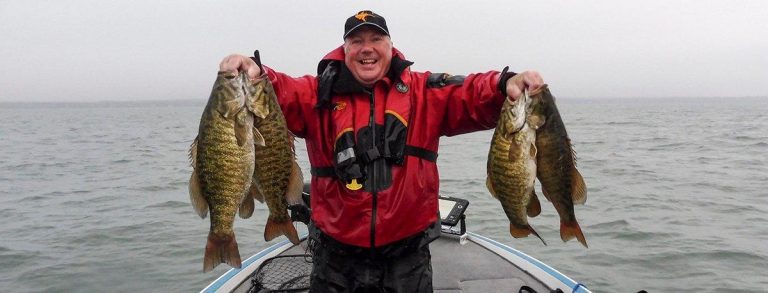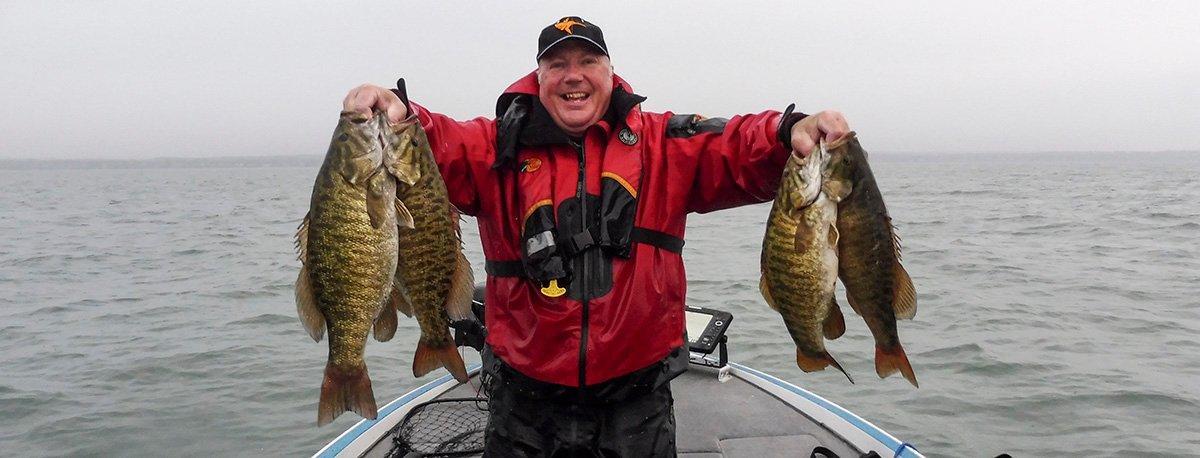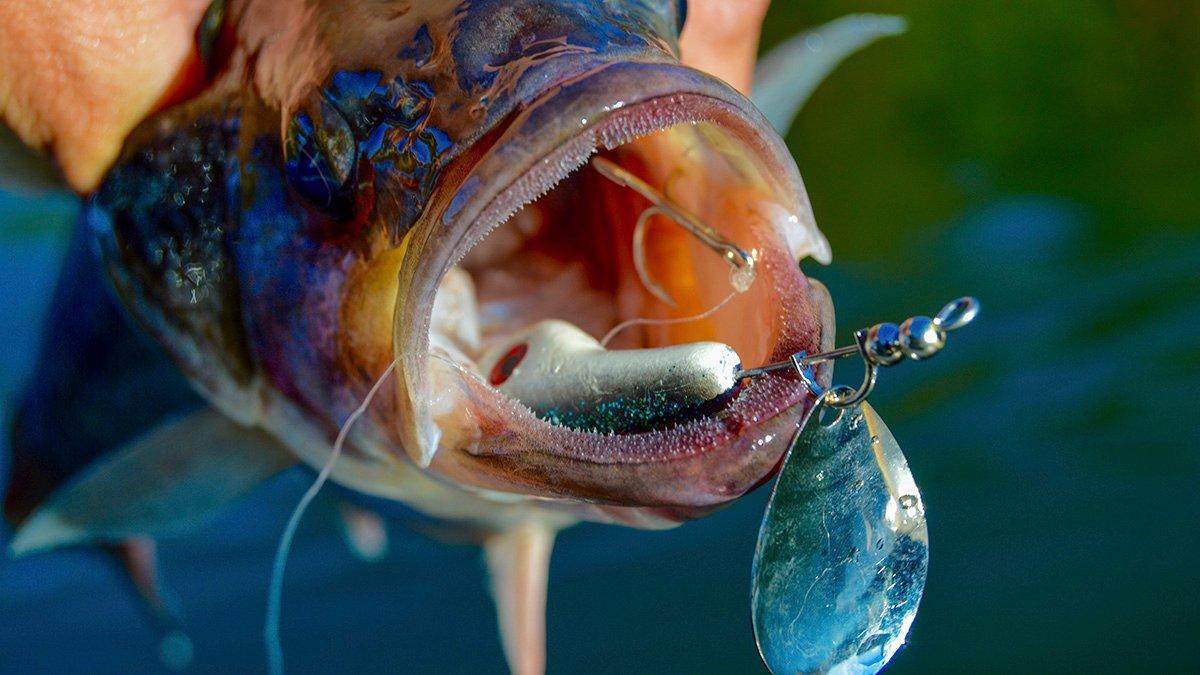Late fall and early winter are some of the best times to catch giant smallmouth bass from Lake Erie. Fishing tubes and jigging spoons around deep rock and gravel points in 30 to 45 foot of water is a reliable approach for hooking smallies just before ice.
This is just a basic recipe, though. Tank-sized smallies won’t make it easy most days. Anglers paying attention to subtle details, such as bottom transitions and presentation tactics, are the ones who return to the boat ramp with mile-wide grins, despite bone-chilling temperatures.
“It’s funny, you can be fishing one color of tube and be getting four pounders from a school, but then you switch colors and you start catching fives or sixes,” said Simon Frost. Frost owns and operates Frostbite Tackle and Guide Service and consistently puts clients on giant smallmouth on Lake Erie, Lake Ontario and the Niagara River.
Here are 5 components to Frost’s game plan for catching big Lake Erie smallmouth in the late fall.
- Fish deep points
- Find gravel
- Zoom in
- Use tubes
- Try spoons
1. Deep points
On Lake Erie, rocky points between 30 and 45 foot consistently hold smallmouth bass from mid October into November. Points appeal to smallmouth as they create a current break.
Massive in size, points are also feeding stations, loaded with gobies, crayfish and baitfish. Bass hunker down, waiting for food to wash up to them.
Anglers should focus on large points attached to land. These structures are travel routes for smallmouth moving deeper from shallow and mid-depth summer habitat as temperatures drop. Open-water oriented, suspending bass also return to these points during fall.

2. Find gravel
Big smallmouth like gravel and sand. Frost uses Humminbird 1100 series and Onix 8 units’ Side Imaging and 360 Imaging to locate bottom composition changes along rocky points. These transitions stack-up big bronzebacks.
“The biggest thing is finding broken rock with gravel,” Frost said. “If you find gravel, you find the fish. Otherwise, it’s sand.”
From football-field sized gravel deposits to spots the size of a driveway, a GPS waypoint’s entered for every patch. Breaks and ledges along the point are also waypointed. These icons comprise a breadcrumb trail for precision drifts on windy days. On rare, calm days, Frost hangs back and casts to these hotspots.
3. Zoom in
Using 2D sonar’s also important for finding big smallmouth. Frost uses zoom to magnify the bottom.
“Even though bass are schooled up, the really big ones are belly to bottom,” Frost said. “Occasionally they’ll come up, but 99 percent of the time they’re right on bottom. You’ve got to have good electronics to find them.”

4. Start with tubes
A 3 1/2-inch tube jig consistently catches fall smallmouth. Smoke and dark green tubes are best to match gobies, crayfish and baitfish on Erie. Rigging on 1/2- to 3/4-ounce Frostbite Fishing Tackle jigheads gives the tubes a fast fall to get smallmouths’ attention. It also keeps the bait on bottom so bass don’t have to chase the meal.
“I never want bait leaving bottom,” Frost said. “The slower you can move it, the more fish you’re going to catch. Even when it’s dead calm, and I’m casting and reeling back to boat, I’m constantly keeping bottom contact with it.”
In wavy, windy conditions, Frost uses drift socks to slow boat speed, aiming for a 1/2 mile-per-hour drift. The tube’s fished vertically so it stays in the sonar cone and is visible on the Humminbird’s display. The electric motor steers the boat to GPS waypoints marking gravel piles, sand patches and contour lines on a point.
Frost uses 5-pound green PowerPro braid with a 15 foot, 10-pound fluorocarbon leader. Frost believes trophy bass get conditioned and spooked by the sound of heavy braid cutting through the water; 5-pound gives him an advantage.
“The only downfall of running 5-pound line is when you snag up, odds are it will break at knot, so you loose your leader, but the extra fish you’re catching makes it worth it,” Frost said. “On average for 10 hours of fishing, I might lose 10 jigs.”
Frost uses a 7-foot, 2-inch Shimano Crucial or 7-foot Zodias medium-action spinning rod for cushion and control over tenacious smallmouth. The smooth drag of a Shimano 2500 CI4+ prevents 5-pound braid from breaking, even when battling 7-pound bronzebacks and incidental giant lake trout catches over 20 pounds.

5. Then try jigging spoons
When smallies snub tubes, Frost uses a jigging spoon to trigger reaction strikes. Top picks are a Bass Pro Shops XPS Tungsten jigging spoon or an ACME Kastmaster in gold or silver. A 3/4-ounce model works best in that deep water.
Like a jig, Frost casts a spoon in calm conditions. When windy, he drift-jigs; a 1-ounce spoon’s often needed to stay vertical.
A quick rod rip lifts the spoon a foot or two off bottom. Then the bait’s allowed to fall on slack line and settle on bottom.
“The key to the spoon is letting it sit and do nothing for two to three seconds,” Frost said. “What happens is when bass aren’t really feeding, they see that flash.”
Frost replaces factory spoon hooks for No. 2 or 4 Trokar or Mustad trebles. While jigging a spoon catches a lot of fish, Frost admits acrobatic smallmouth can shake the heavy bait free sometimes.
Frost fishes spoons on 10-pound PowerPro braid with a 12- to 14-pound fluorocarbon leader with a 7-foot medium action casting rod and high-speed casting reel.
Consider Frost’s smallmouth tips if planning to visit the Great Lakes in search of giant smallmouth bass in the late fall. Locate gravel and sandy areas on rocky points using electronics and work the bottom with a tube jig or jigging spoon. Big water can get breezy in fall just before ice, so drift socks can be a necessary item.

















